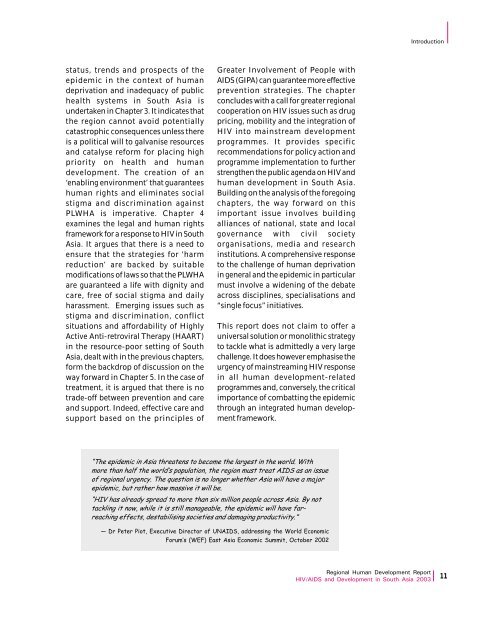Download Report - UNDP Asia-Pacific Regional Centre - United ...
Download Report - UNDP Asia-Pacific Regional Centre - United ...
Download Report - UNDP Asia-Pacific Regional Centre - United ...
You also want an ePaper? Increase the reach of your titles
YUMPU automatically turns print PDFs into web optimized ePapers that Google loves.
Introductionstatus, trends and prospects of theepidemic in the context of humandeprivation and inadequacy of publichealth systems in South <strong>Asia</strong> isundertaken in Chapter 3. It indicates thatthe region cannot avoid potentiallycatastrophic consequences unless thereis a political will to galvanise resourcesand catalyse reform for placing highpriority on health and humandevelopment. The creation of an‘enabling environment’ that guaranteeshuman rights and eliminates socialstigma and discrimination againstPLWHA is imperative. Chapter 4examines the legal and human rightsframework for a response to HIV in South<strong>Asia</strong>. It argues that there is a need toensure that the strategies for ‘harmreduction’ are backed by suitablemodifications of laws so that the PLWHAare guaranteed a life with dignity andcare, free of social stigma and dailyharassment. Emerging issues such asstigma and discrimination, conflictsituations and affordability of HighlyActive Anti-retroviral Therapy (HAART)in the resource-poor setting of South<strong>Asia</strong>, dealt with in the previous chapters,form the backdrop of discussion on theway forward in Chapter 5. In the case oftreatment, it is argued that there is notrade-off between prevention and careand support. Indeed, effective care andsupport based on the principles ofGreater Involvement of People withAIDS (GIPA) can guarantee more effectiveprevention strategies. The chapterconcludes with a call for greater regionalcooperation on HIV issues such as drugpricing, mobility and the integration ofHIV into mainstream developmentprogrammes. It provides specificrecommendations for policy action andprogramme implementation to furtherstrengthen the public agenda on HIV andhuman development in South <strong>Asia</strong>.Building on the analysis of the foregoingchapters, the way forward on thisimportant issue involves buildingalliances of national, state and localgovernance with civil societyorganisations, media and researchinstitutions. A comprehensive responseto the challenge of human deprivationin general and the epidemic in particularmust involve a widening of the debateacross disciplines, specialisations and“single focus” initiatives.This report does not claim to offer auniversal solution or monolithic strategyto tackle what is admittedly a very largechallenge. It does however emphasise theurgency of mainstreaming HIV responsein all human development-relatedprogrammes and, conversely, the criticalimportance of combatting the epidemicthrough an integrated human developmentframework.“The epidemic in <strong>Asia</strong> threatens to become the largest in the world. Withmore than half the world’s population, the region must treat AIDS as an issueof regional urgency. The question is no longer whether <strong>Asia</strong> will have a majorepidemic, but rather how massive it will be.“HIV has already spread to more than six million people across <strong>Asia</strong>. By nottackling it now, while it is still manageable, the epidemic will have farreachingeffects, destabilising societies and damaging productivity.”— Dr Peter Piot, Executive Director of UNAIDS, addressing the World Economicorum’s (WE) East <strong>Asia</strong> Economic Summit, October 2002<strong>Regional</strong> Human Development <strong>Report</strong>HIV/AIDS and Development in South <strong>Asia</strong> 2003 11
















